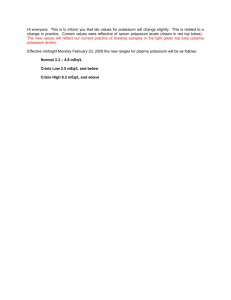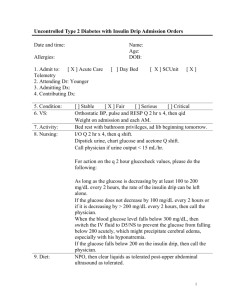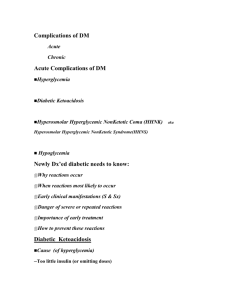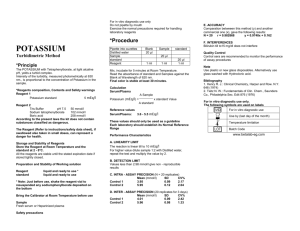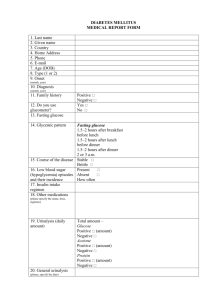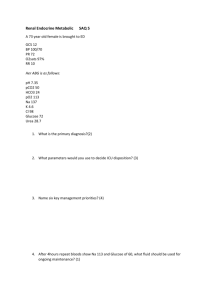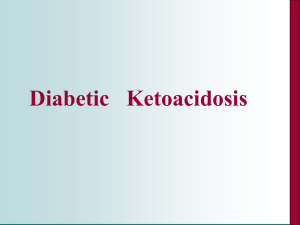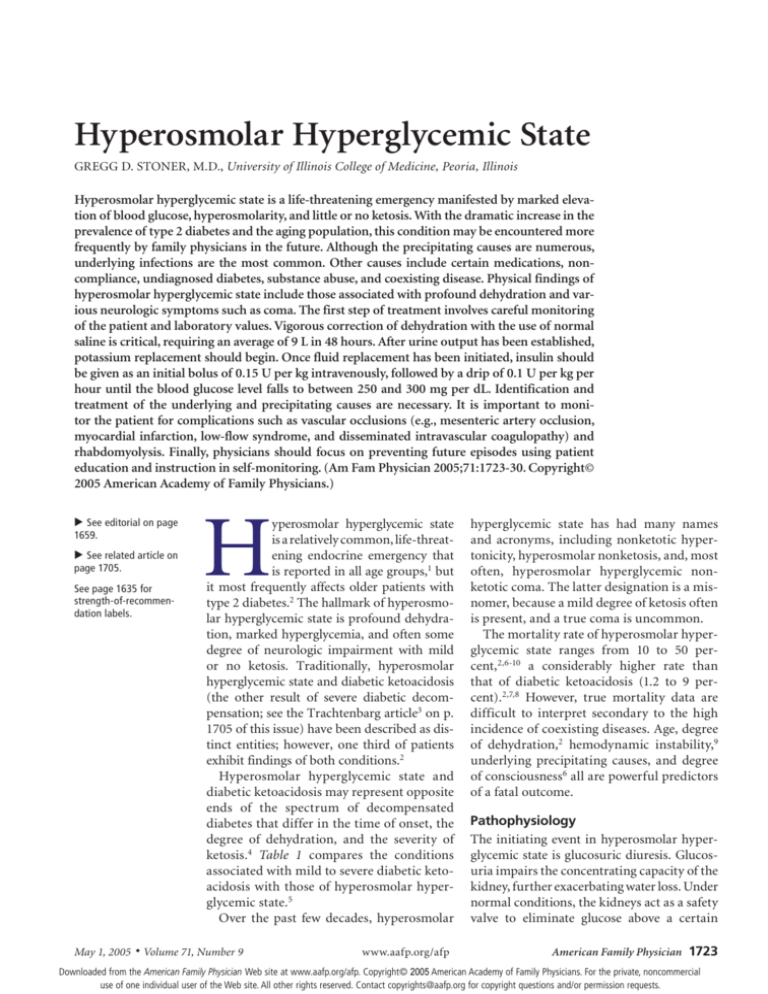
Hyperosmolar Hyperglycemic State
GREGG D. STONER, M.D., University of Illinois College of Medicine, Peoria, Illinois
Hyperosmolar hyperglycemic state is a life-threatening emergency manifested by marked elevation of blood glucose, hyperosmolarity, and little or no ketosis. With the dramatic increase in the
prevalence of type 2 diabetes and the aging population, this condition may be encountered more
frequently by family physicians in the future. Although the precipitating causes are numerous,
underlying infections are the most common. Other causes include certain medications, noncompliance, undiagnosed diabetes, substance abuse, and coexisting disease. Physical findings of
hyperosmolar hyperglycemic state include those associated with profound dehydration and various neurologic symptoms such as coma. The first step of treatment involves careful monitoring
of the patient and laboratory values. Vigorous correction of dehydration with the use of normal
saline is critical, requiring an average of 9 L in 48 hours. After urine output has been established,
potassium replacement should begin. Once fluid replacement has been initiated, insulin should
be given as an initial bolus of 0.15 U per kg intravenously, followed by a drip of 0.1 U per kg per
hour until the blood glucose level falls to between 250 and 300 mg per dL. Identification and
treatment of the underlying and precipitating causes are necessary. It is important to monitor the patient for complications such as vascular occlusions (e.g., mesenteric artery occlusion,
myocardial infarction, low-flow syndrome, and disseminated intravascular coagulopathy) and
rhabdomyolysis. Finally, physicians should focus on preventing future episodes using patient
education and instruction in self-monitoring. (Am Fam Physician 2005;71:1723-30. Copyright©
2005 American Academy of Family Physicians.)
▲
See editorial on page
1659.
▲
See related article on
page 1705.
See page 1635 for
strength-of-recommendation labels.
May 1, 2005
◆
H
yperosmolar hyperglycemic state
is a relatively common, life-threatening endocrine emergency that
is reported in all age groups,1 but
it most frequently affects older patients with
type 2 diabetes.2 The hallmark of hyperosmolar hyperglycemic state is profound dehydration, marked hyperglycemia, and often some
degree of neurologic impairment with mild
or no ketosis. Traditionally, hyperosmolar
hyperglycemic state and diabetic ketoacidosis
(the other result of severe diabetic decompensation; see the Trachtenbarg article3 on p.
1705 of this issue) have been described as distinct entities; however, one third of patients
exhibit findings of both conditions.2
Hyperosmolar hyperglycemic state and
diabetic ketoacidosis may represent opposite
ends of the spectrum of decompensated
diabetes that differ in the time of onset, the
degree of dehydration, and the severity of
ketosis.4 Table 1 compares the conditions
associated with mild to severe diabetic ketoacidosis with those of hyperosmolar hyperglycemic state.5
Over the past few decades, hyperosmolar
Volume 71, Number 9
www.aafp.org/afp
hyperglycemic state has had many names
and acronyms, including nonketotic hypertonicity, hyperosmolar nonketosis, and, most
often, hyperosmolar hyperglycemic nonketotic coma. The latter designation is a misnomer, because a mild degree of ketosis often
is present, and a true coma is uncommon.
The mortality rate of hyperosmolar hyperglycemic state ranges from 10 to 50 percent,2,6-10 a considerably higher rate than
that of diabetic ketoacidosis (1.2 to 9 percent).2,7,8 However, true mortality data are
difficult to interpret secondary to the high
incidence of coexisting diseases. Age, degree
of dehydration,2 hemodynamic instability,9
underlying precipitating causes, and degree
of consciousness6 all are powerful predictors
of a fatal outcome.
Pathophysiology
The initiating event in hyperosmolar hyperglycemic state is glucosuric diuresis. Glucosuria impairs the concentrating capacity of the
kidney, further exacerbating water loss. Under
normal conditions, the kidneys act as a safety
valve to eliminate glucose above a certain
American Family Physician 1723
Downloaded from the American Family Physician Web site at www.aafp.org/afp. Copyright© 2005 American Academy of Family Physicians. For the private, noncommercial
use of one individual user of the Web site. All other rights reserved. Contact copyrights@aafp.org for copyright questions and/or permission requests.
Strength of Recommendations*
Key clinical recommendation
Label
Reference
Fluid and electrolyte replacement should be initiated based on the
recommendations in the ADA algorithm.
Once fluids have been started, continuous insulin therapy can be initiated.
Phosphate replacement should be considered only if hypophosphatemia is
severe (less than 1.0 mg per dL) or if respiratory depression, anemia, and
cardiac dysfunction are comorbidities.
Patients should be assessed carefully and treated for underlying causes
of hyperosmolar hyperglycemic state.
Physicians should work with the patient, family, and caregivers to help
prevent future occurrences.
A
32
A
A
32
32
C
32
C
32
ADA = American Diabetes Association
A = consistent, good quality patient-oriented evidence; B = inconsistent or limited quality patient-oriented evidence;
C = consensus, disease-oriented evidence, usual practice, opinion, or case series. See page 1635 for more information.
*—Strength of recommendation labels are based on Kitabchi AE, Umpierrez GE, Murphy MB, Barrett EJ, Kreisberg RA,
Malone JI, et al. Hyperglycemic crises in diabetes. Diabetes Care 2004;27(suppl 1):S94-102.
threshold and prevent further accumulation.
However, decreased intravascular volume or
underlying renal disease decreases the glomerular filtration rate, causing the glucose
level to increase. The loss of more water than
sodium leads to hyperosmolarity.10 Insulin is
present, but it is not adequate to reduce blood
glucose levels, particularly in the presence of
significant insulin resistance.11
Precipitating Factors
Precipitating factors may be divided into
six categories: infections, medications, non-
compliance, undiagnosed diabetes, substance
abuse, and coexisting diseases (Table 2).11-17
Infections are the leading cause of hyperosmolar hyperglycemic state (57.1 percent)6;
the most common infection is pneumonia,
often gram negative, followed by urinary
tract infection and sepsis.13 Poor compliance
with diabetic medications also is thought to
be a frequent cause (21 percent).6
Undiagnosed diabetes often is associated with hyperosmolar hyperglycemic
state because of failure to recognize early
symptoms of the disease. Myocardial infarc-
TABLE 1
Comparison of Diabetic Ketoacidosis to Hyperosmolar Hyperglycemic State
Diabetic ketoacidosis
Variables
Mild
Moderate
Severe
Hyperosmolar
hyperglycemic state
Plasma glucose level
(mg per dL [mmol per L])
Arterial pH level
Serum bicarbonate level
(mEq per L)
Urine or serum ketones
Effective serum osmolality
(mOsm per kg)
Anion gap
Alternative sensoria in
mental obtundation
> 250 (13.9)
> 250
> 250
> 600 (33.3)
7.25 to 7.30
15 to 18
7.00 to 7.24
10 to < 15
< 7.00
< 10
> 7.30
> 15
Positive
Variable
Positive
Variable
Positive
Variable
Small or negative
> 320
> 10
Alert
> 12
Alert,
drowsy
> 12
Stupor, coma
Variable
Stupor, coma
Adapted with permission from Kitabchi AE, Umpierrez GE, Murphy MB, Barrett EJ, Kreisberg RA, Malone JI, et al.
Hyperglycemic crises in diabetes. Diabetes Care 2004;27(suppl 1):S95.
1724 American Family Physician
www.aafp.org/afp
Volume 71, Number 9
◆
May 1, 2005
Hyperosmolar Hyperglycemic State
tion,13,16 cerebrovascular accident, pulmonary embolus, and mesenteric thrombosis
have been identified as causes of hyperosmolar hyperglycemic state. In one study18 of an
urban population presenting with hyperosmolar hyperglycemic state, the three leading
causes were poor compliance with medication, ethanol ingestion, and cocaine use.
Long-term steroid use19 and gastroenteritis20
are common causes of hyperosmolar hyperglycemic state in children.
Clinical Evaluation
Typically, patients presenting with hyperosmolar hyperglycemic state are older and have
undiagnosed diabetes or type 2 diabetes managed by diet and/or oral diabetic medication.
They often take medications that aggravate
the problem, such as a diuretic that causes
mild dehydration. These patients often live
alone or may be in a nursing home environment in which they are unable to communicate their needs secondary to restraints,
sedation, or coma.21
In addition to one or more of the precipitating factors listed in Table 2,11-17 patients with
hyperosmolar hyperglycemic state typically
present with weakness, visual disturbance,
or leg cramps.10,21 Nausea and vomiting may
occur, but are much less frequent than in
patients with diabetic ketoacidosis. Eventually, patients develop neurologic symptoms
of lethargy, confusion, hemiparesis (often
misdiagnosed as cerebrovascular accident),
seizures, or coma10,13,22 that eventually lead
to medical care.
Physical findings reveal profound dehydration that is manifested by poor tissue turgor10 (which may be difficult to evaluate in
older patients)23 ; dry buccal mucosa membranes; soft, sunken eyeballs; cool extremities; and a rapid, thready pulse.10 A low-grade
fever often is present. Abdominal distention
may occur because of gastroparesis induced
by hypertonicity,23 but resolves quickly following adequate rehydration. Abdominal
distention that persists after rehydration
may be related to other underlying causes.
Various changes in mental status may manifest, ranging from complete lucidity to disorientation to lethargy to coma. The degree
May 1, 2005
◆
Volume 71, Number 9
of neurologic impairment is
related directly to the effective
serum osmolarity,15 with coma
often occurring once the serum
osmolarity is greater than 350
mOsm per kg (350 mmol per
kg). Seizures are present in up to
25 percent of patients and may
be generalized, focal, myoclonic
jerking, or movement induced.23
Hemiparesis may occur,13,23 but
it is reversible with correction of
the fluid deficit.
Typical laboratory findings
in hyperosmolar hyperglycemic state include blood
glucose levels greater than
600 mg per dL (33.3 mmol
per L), serum osmolarity
greater than 320 mOsm per
kg, pH levels greater than
7.30, and mild or absent
ketonemia.
Diagnostic Testing
Initial laboratory findings in patients with
hyperosmolar hyperglycemic state include
marked elevations in blood glucose (greater
than 600 mg per dL [33.3 mmol per L]) and
serum osmolarity (greater than 320 mOsm
per kg of water [normal = 290 ± 5]), with a
pH level greater than 7.30 and mild or absent
ketonemia. One half of patients will demon-
TABLE 2
Precipitating Factors in Hyperosmolar Hyperglycemic State
Coexisting diseases
Acute myocardial infarction
Adrenocorticotropic hormoneproducing tumors
Cerebrovascular accident
Cushing’s syndrome
Hyperthermia
Hypothermia
Mesenteric thrombosis
Pancreatitis
Pulmonary embolus
Renal failure
Severe burns
Thyrotoxicosis
Infection
Cellulitis
Dental infections
Pneumonia
Sepsis
Urinary tract infection
Medications
Calcium channel blockers
Chemotherapeutic agents
Chlorpromazine (Thorazine)
Cimetidine (Tagamet)
Diazoxide (Hyperstat)
Glucocorticoids
Loop diuretics
Olanzapine (Zyprexa)
Phenytoin (Dilantin)
Propranolol (Inderal)
Thiazide diuretics
Total parenteral nutrition
Noncompliance
Substance abuse
Alcohol
Cocaine
Undiagnosed diabetes
Information from references 11 through 17.
www.aafp.org/afp
American Family Physician 1725
TABLE 3
Electrolyte Losses in Hyperosmolar
Hyperglycemic State
Electrolytes
Losses
Sodium
Chloride
Potassium
Phosphate
Calcium
Magnesium
Water
7 to 13 mEq per kg
3 to 7 mEq per kg
5 to 15 mEq per kg
70 to 140 mmol per kg
50 to 100 mEq per kg
50 to 100 mEq per kg
100 to 200 mL per kg
Information from reference 10.
strate a mild anion-gap metabolic acidosis
(i.e., 10 to 12). If the anion gap is severe (i.e.,
greater than 12), the differential diagnosis
should include lactic acidosis or other entities not related to hyperosmolar hyperglycemic state. Vomiting and use of thiazide
diuretics may cause a metabolic alkalosis
that could mask the severity of acidosis.13
Serum potassium levels may be elevated or
normal.13 Creatinine, blood urea nitrogen
(BUN), and hematocrit levels are almost
always elevated.24 Hyperosmolar hyperglycemic state produces significant total body
losses of many electrolytes (Table 3).10
The reported sodium level should be
corrected when the patient’s glucose level
is markedly elevated. The types of fluids
administered depend on the corrected serum
sodium level,25 which is calculated using the
following formula13,26 :
Corrected serum sodium =
sodium
(mEq per L) +
1.65 � (glucose [mg per dL] – 100)
100
For example, if the reported serum sodium
level was 145 mEq per L (145 mmol per L)
and the glucose level was 1,100 mg per dL
(61.1 mmol per L):
Corrected serum sodium =
145 +
1.65 � (1,100 – 100)
100
= 145 + 16.5 =
161.5
mEq per kg
Although some formulas for calculating
osmolarity include the BUN level, because
it is in equal distribution in the intracellular and extracellular spaces, BUN does not
contribute to the “effective” serum osmolar1726 American Family Physician
www.aafp.org/afp
ity, which is calculated using the following
formula:
Effective serum osmolarity =
(2 � sodium [mEq per L]) +
glucose (mg per dL)
18
Although potassium is included in some
formulas, it is not included in the formula
recommended by the American Diabetes
Association (ADA).
For example, if the sodium level was
150 mEq per L (150 mmol per L), and the
glucose level was 1,100 mg per dL:
Effective serum osmolarity =
(2 � 150) +
1,100
18
= 300 + 51 = 351 mOsm per kg
Treatment
The treatment of hyperosmolar hyperglycemic state involves a five-pronged approach:
(1) vigorous intravenous rehydration, (2)
electrolyte replacement, (3) administration of
intravenous insulin, (4) diagnosis and management of precipitating and coexisting problems, and (5) prevention.24 An evidence-based
algorithm from the ADA that summarizes the
management of adults with hyperosmolar
hyperglycemic state is shown in Figure 1.5
Patients should be managed in the intensive
care environment if they have any cardiovascular instability, are unable to maintain an
airway, have obtundation or acute abdominal
symptoms, or if they cannot be monitored
adequately on the general medical ward.27
Management of children with hyperosmolar hyperglycemic state generally follows
that of adults. While a detailed discussion
of the management of hyperosmolar hyperglycemic state in children and adolescents
is beyond the scope of this article, an algorithm from the ADA guideline is included
in the Trachtenbarg3 article on page 1705 of
this issue. A chart for the management of
patients with hyperosmolar hyperglycemic
state is provided in the ADA guideline, and
it is available online at http://care.diabetes
journals.org/content/vol25/issue90001/
images/large/dc1110012004.jpeg.
Volume 71, Number 9
◆
May 1, 2005
Hyperosmolar Hyperglycemic State
Management of Adult Patients with Hyperosmolar Hyperglycemic State*
Complete initial evaluation.† Start IV fluids: 1.0 L of 0.9 percent sodium chloride per hour initially.
IV fluids
Insulin
Potassium
Determine hydration status.
Regular, 0.15 U per kg
as IV bolus
If initial serum potassium is
3.3 mEq per L (3.3 mmol
per L), hold insulin and
give 40 mEq potassium
(2/3 as potassium chloride
and 1/3 as potassium
phosphate) until potassium
≥ 3.3 mEq per L.
Hypovolemic shock
Mild hypotension
Cardiogenic shock
Administer
0.9 percent
sodium chloride
(1.0 L per hour)
and/or plasma
expanders.
Evaluate corrected
serum sodium.‡
Hemodynamic
monitoring
High
Normal
0.45 percent sodium chloride
(4 to 14 mL per kg per
hour ) depending on
state of hydration
Low
0.9 percent sodium chloride
(4 to 14 mL per kg per
hour ) depending on
state of hydration
0.1 U per kg per hour
IV insulin infusion
Check serum glucose
hourly. If serum
glucose does not fall
by at least 50 mg
per dL in the first
hour, then double
insulin dose hourly
until glucose falls at a
steady hourly rate of
50 to 70 mg per dL.
When serum glucose reaches 300 mg per dL (16.7 mmol per L)
Change to 5 percent dextrose with 0.45 percent sodium
chloride, and decrease insulin to 0.05 to 0.1 U per kg per
hour to maintain serum glucose between 250 mg per dL
(13.0 mmol per L) and 300 mg per dL until plasma osmolality
is ≤ 315 mOsm per kg and the patient is mentally alert.
Check electrolyte, BUN,
creatinine, and glucose
levels every two to four
hours until stable. After
resolution of hyperosmolar
hyperglycemic state, if
the patient is unable to
eat, continue IV insulin
and supplement with SC
regular insulin as needed.
When the patient can
eat, initiate SC insulin or
previous treatment regimen
and assess metabolic
control. Continue to look
for precipitating cause(s).
If initial serum potassium
is ≥ 5.0 mEq per L
(5.0 mmol per L), do
not give potassium but
check serum potassium
every two hours.
If initial serum potassium is
≥ 3.3 but < 5.0 mEq per L,
give 20 to 30 mEq
potassium in each liter of
IV fluid (2/3 as potassium
chloride and 1/3 as
potassium phosphate) to
keep serum potassium at
4.0 mEq per L (4.0 mmol
per L) to 5.0 mEq per L.
*—Diagnostic criteria: blood glucose level > 600 mg per dL (33.3 mmol per L), arterial pH level > 7.3, bicarbonate level > 15 mEq per L, mild ketonuria or ketonemia, and effective serum osmolality > 320 mOsm per kg of water. This protocol is for patients admitted with mental status change or
severe dehydration who require admission to an intensive care unit. For less severe cases, see text for management guidelines. Normal ranges vary
by laboratory; check local laboratory normal ranges for all electrolytes.
Effective serum osmolality calculation: (2 sodium [mEq per L]) + (glucose [mg per dL] ÷ 18).
†—After history and physical examination, immediately obtain arterial blood gases, complete blood count with differential, urinalysis, plasma glucose, BUN, electrolytes, chemistry profile, creatinine levels, and an electrocardiogram. Obtain chest radiograph and cultures as needed.
‡—Serum sodium should be corrected for hyperglycemia (for each 100 mg per dL of glucose > 100 mg per dL, add 1.6 mEq to sodium value for
corrected serum value).
Figure 1. Protocol for the management of adult patients with hyperosmolar hyperglycemic state. (BUN = blood urea
nitrogen; IV = intravenous; SC = subcutaneous)
Adapted with permission from Kitabchi AE, Umpierrez GE, Murphy MB, Barrett EJ, Kreisberg RA, Malone JI, et al. Hyperglycemic crises in diabetes. Diabetes
Care 2004;27(suppl 1):S97.
May 1, 2005
◆
Volume 71, Number 9
www.aafp.org/afp
American Family Physician 1727
FLUID REPLACEMENT
The first and most important step in the
treatment of hyperosmolar hyperglycemic
state is aggressive fluid replacement, which
should begin with an estimate of the fluid
deficit (usually 100 to 200 mL per kg, or
an average total of 9 L).5,13 The use of isotonic fluids may cause fluid overload and
hypotonic fluids may correct deficits too
rapidly with a potential for diffuse myelinolysis and death.13 Therefore, 1 L of normal
saline should be given per hour to start. If
the patient is in hypervolemic shock, plasma
expanders also may be needed. If the patient
is in cardiogenic shock, hemodynamic monitoring is required. Details about the addition
of potassium to the intravenous fluids are
provided in the next section.
Once there is only mild hypotension, the
corrected serum sodium level should be
calculated. If the corrected serum sodium
level is high (greater than 145 mEq per L) or
normal (135 mEq per L [135 mmol per L] to
145 mEq per L), then 0.45 percent sodium
chloride may be administered at a rate of
4 to 14 mL per kg per hour depending on the
state of dehydration. If the corrected serum
sodium level is low (less than 135 mEq per
L), 0.9 percent sodium chloride is infused
at the same rate. When the serum glucose
level is less than 300 mg per dL (16.7 mmol
per L), the fluid may be changed to 5 percent
dextrose solution with 0.45 percent sodium
chloride.13,25 One half of the calculated deficit should be given in the first 18 to 24 hours
and the remainder over the next 24 hours.
In adults, the risk of cerebral edema is low
and the consequences of undertreatment
include vascular occlusion and increased rate
of mortality. Good clinical judgment should
The Author
GREGG D. STONER, M.D., is director of fellowship programs and professor of
clinical family and community medicine at the University of Illinois College of
Medicine, Peoria. He received his medical degree from the University of Illinois
College of Medicine and completed his residency training in family medicine at
Methodist Medical Center, University of Illinois College of Medicine.
Address correspondence to Gregg D. Stoner, M.D., University of Illinois College
of Medicine, Director of Fellowship Programs, 815 Main St., Suite B, Peoria, IL
61602 (e-mail: gstoner@uic.edu). Reprints are not available from the author.
1728 American Family Physician
www.aafp.org/afp
be employed, especially when the patient has
comorbid conditions such as acute myocardial infarction, a history of congestive heart
failure, or renal failure. In such cases, close
hemodynamic monitoring is indicated.
Early in the course of treatment, the plasma
glucose level will decrease, even before insulin is started, and this may serve as an index
for the adequacy of fluid replacement.10 If
the plasma glucose level fails to decline by
75 to 100 mg per dL (4.2 to 5.6 mmol per L)
per hour, this usually implies inadequate
fluid volume or renal impairment.10
Children are at greater risk of developing potentially fatal cerebral edema during
treatment. For this reason, the rate at which
serum tonicity is returned to normal should
be somewhat slower than in adults.28
ELECTROLYTE MANAGEMENT
Electrolyte replacement is critical. Total
body potassium depletion often is unrecognized10 because the level of potassium
in the blood may be normal or high.13 The
serum potassium level may plummet when
insulin is replaced because this forces potassium into the cell. Once urine output is
established, potassium replacement should
be initiated. Electrolytes should be followed
closely (every one to two hours initially)
and the patient’s cardiac rhythm should be
monitored continuously.
If the patient’s serum potassium level is less
than 3.3 mEq per L (3.3 mmol per L) initially,
insulin should be held and potassium given
as two thirds potassium chloride and one
third potassium phosphate until the potassium level reaches at least 3.3 mEq per L. If
the potassium level is greater than 5.0 mEq
per L (5.0 mmol per L), potassium should be
held until the level is less than 5.0 mEq per L,
but the potassium level should be monitored
every two hours. If the initial serum potassium level is between 3.3 and 5.0 mEq per L,
20 to 30 mEq of potassium should be given in
each liter of intravenous fluid (two thirds as
potassium chloride, one third as potassium
phosphate) to maintain the serum potassium
level between 4.0 mEq per L (4.0 mmol per L)
and 5.0 mEq per L.25
Despite a lack of evidence that treatment
Volume 71, Number 9
◆
May 1, 2005
Hyperosmolar Hyperglycemic State
with phosphate, calcium, or magnesium
alters outcomes,23 these electrolytes must
be considered. Most studies1,5,10 that have
examined the need for phosphate replacement involved patients with diabetic ketoacidosis that developed over hours to days.
However, because hyperosmolar hyperglycemic state occurs slowly (over days to weeks),
the patient is much more likely to be phosphate depleted.
Although phosphate replacement makes
physiologic sense, no controlled data have
demonstrated improved outcomes.10 Phosphate replacement may be considered when
the patient’s serum phosphate level is below
1.0 mEq per L (1.0 mmol per L) and muscle
weakness is a concern, as in patients with
respiratory impairment. Because phosphate
replacement can cause severe hypocalcemia
in this setting, serum calcium levels should
be monitored closely.25
Hypomagnesemia may manifest as arrhythmias, muscle weakness, convulsions, stupor, and agitation. Hypomagnesemia may be
present in up to 90 percent of patients with
uncontrolled diabetes.10 Unless the patient
is in renal failure, administration of magnesium is safe and physiologic.
INSULIN THERAPY
The critical point regarding insulin management is to remember that adequate fluids
must be given first. If insulin is administered
before fluids, the water will move intracellularly, causing potential worsening of hypotension, vascular collapse, or death. Insulin
should be given as an initial bolus of 0.15 U
per kg intravenously, followed by a drip of
0.1 U per kg per hour until the blood glucose
level falls to between 250 mg per dL (13.9
mmol per L) and 300 mg per dL. If the glucose
level does not decrease by 50 to 70 mg per dL
per hour, this rate of administration may be
doubled. Once the serum glucose concentration is below 300 mg per dL, dextrose should
be added to the intravenous fluid and insulin
should be titrated by a low-dose sliding scale
until the mental obtundation and hyperosmolarity are resolved. When the patient is able
to eat, subcutaneous insulin or the previous
treatment regimen may be initiated.1
May 1, 2005
◆
Volume 71, Number 9
IDENTIFY AND TREAT THE CAUSE
Although routine administration of antibiotics for all patients with suspected infection
is not recommended, antibiotic therapy is
warranted while awaiting culture results in
older patients or in those with hypotension.
According to a recent study,29 elevated Creactive protein and interleukin-6 levels are
early indicators of sepsis in patients with
hyperosmolar hyperglycemic state.
It also is important to review any medications that may have precipitated or aggravated the event, and discontinue or reduce
the dosage of any suspected agent. Investigation of other causes may be performed as
indicated after reviewing the list of precipitating factors listed in Table 2.11-17
Complications of Treatment
Complications from inadequate treatment
include vascular occlusions (e.g., mesenteric
artery occlusion, myocardial infarction, lowflow syndrome, and disseminated intravascular
coagulopathy)10,27 and rhabdomyolysis.11,24,30
Overhydration may lead to adult respiratory distress syndrome and induced cerebral
edema, which is rare but often fatal in children
and young adults. Cerebral edema should be
treated with intravenous mannitol (Osmitrol)
in a dose of 1 to 2 g per kg over 30 minutes
and intravenous dexamethasone (Decadron).
Slowing the correction of hyperosmolarity in
children may prevent cerebral edema.28
Prevention
The patient and another responsible party
should be engaged in a significant educational
effort that encourages adherence to blood
glucose monitoring and compliance with prescribed medications. It is especially important
that the patient have access to an adequate
water supply. If the patient lives alone, a family member or friend should check in on the
patient daily to watch for any changes in mental status and to notify the physician if this
occurs. In the nursing home setting, the above
recommendations should be followed and the
nursing home staff should be educated regarding the signs and symptoms of hyperosmolar
hyperglycemic state and the importance of
adequate fluid intake and monitoring.10,23,24
www.aafp.org/afp
American Family Physician 1729
Hyperosmolar Hyperglycemic State
The author thanks John G. Halvorsen, M.D., and Roberta
L. Van Zant, D.O., of the University of Illinois, College of
Medicine, Peoria, and Pamela Kimberlin, Lora Murphy,
Burgitta Sujdak, and Theresa Anderson for assistance in
the preparation of this manuscript.
Members of various family medicine departments
develop articles for “Practical Therapeutics.” This article
is one in a series coordinated by the Department of
Family and Community Medicine at the University of
Illinois at Chicago, Rockford. Guest editor of the series is
Eric Henley, M.D.
The author indicates that he does not have any conflicts
of interest. Sources of funding: none reported.
REFERENCES
1. Chiasson JL, Aris-Jilwan N, Belanger R, Bertrand S,
Beauregard H, Ekoe JM, et al. Diagnosis and treatment
of diabetic ketoacidosis and the hyperglycemic hyperosmolar state [published correction appears in CMAJ
2003;168:1241]. CMAJ 2003;168:859-66.
2. MacIsaac RJ, Lee LY, McNeil KJ, Tsalamandris C, Jerums
G. Influence of age on the presentation and outcome of
acidotic and hyperosmolar diabetic emergencies. Intern
Med J 2002;32:379-85.
3. Trachtenbarg DE. Diabetic ketoacidosis. Am Fam Physician 2005;71:1705-14,1721-2.
4. Gonzalez-Campoy JM, Robertson RP. Diabetic ketoacidosis and hyperosmolar nonketotic state: gaining
control over extreme hyperglycemic complications.
Postgrad Med 1996;99:143-52.
13. Trence DL, Hirsch IB. Hyperglycemic crises in diabetes
mellitus type 2. Endocrinol Metab Clin North Am
2001;30:817-31.
14. Roefaro J, Mukherjee SM. Olanzapine-induced
hyperglycemic nonketonic coma. Ann Pharmacother
2001;35:300-2.
15. Munshi MN, Martin RE, Fonseca VA. Hyperosmolar
nonketotic diabetic syndrome following treatment of
human immunodeficiency virus infection with didanosine. Diabetes Care 1994;17:316-7.
16. Yildiz M, Gul L, Ozbay G. Hyperosmolar hyperglycaemic nonketotic coma associated with acute myocardial infarction: report of three cases. Acta Cardiol
2002;57:271-4.
17. Gooch BR. Cushing’s syndrome manifesting as pseudocentral hypothyroidism and hyperosmolar diabetic
coma. Endocr Pract 2002;8:119-23.
18. Umpierrez GE, Kelly JP, Navarrete JE, Casals MM,
Kitabchi AE. Hyperglycemic crises in urban blacks. Arch
Intern Med 1997;157:669-75.
19. Yang JY, Cui XL, He XJ. Non-ketotic hyperosmolar coma
complicating steroid treatment in childhood nephrosis.
Pediatr Nephrol 1995;9:621-2.
20. Rother KI, Schwenk WF 2d. An unusual case of the
nonketotic hyperglycemic syndrome during childhood.
Mayo Clin Proc 1995;70:62-5.
21. Wachtel TJ, Silliman RA, Lamberton P. Predisposing
factors for the diabetic hyperosmolar state. Arch Intern
Med 1987;147:499-501.
22. Ting JY. Hyperosmolar diabetic non-ketotic coma,
hyperkalaemia and an unusual near death experience.
Eur J Emerg Med 2001;8:57-63.
5. Kitabchi AE, Umpierrez GE, Murphy MB, Barrett EJ,
Kreisberg RA, Malone JI, et al. Hyperglycemic crises in
diabetes. Diabetes Care 2004;27(suppl 1):S94-102.
23. Delaney MF, Zisman A, Kettyle WM. Diabetic ketoacidosis and hyperglycemic hyperosmolar nonketotic syndrome. Endocrinol Metab Clin North Am 2000;29:683705.
6. Chu CH, Lee JK, Lam HC, Lu CC. Prognostic factors of
hyperglycemic hyperosmolar nonketotic state. Chang
Gung Med J 2001;24:345-51.
24. Genuth SM. Diabetic ketoacidosis and hyperglycemic hyperosmolar coma. Curr Ther Endocrinol Metab
1997;6:438-47.
7. Zouvanis M, Pieterse AC, Seftel HC, Joffe BI. Clinical characteristics and outcome of hyperglycaemic
emergencies in Johannesburg Africans. Diabet Med
1997;14:603-6.
25. Matz R. Hyponatremia: evaluating the correction factor
for hyperglycemia. Am J Med 2000;108:180-1.
8. Rolfe M, Ephraim GG, Lincoln DC, Huddle KR. Hyperosmolar non-ketotic diabetic coma as a cause of
emergency hyperglycaemic admission to Baragwanath
Hospital. S Afr Med J 1995;85:173-6.
9. Pinies JA, Cairo G, Gaztambide S, Vazquez JA. Course
and prognosis of 132 patients with diabetic non ketotic
hyperosmolar state. Diabete Metab 1994;20:43-8.
10. Matz R. Management of the hyperosmolar hyperglycemic syndrome. Am Fam Physician 1999;60:1468-76.
11. Gupta S, Prabhu MR, Gupta MS, Niblett D. Severe nonketotic hyperosmolar coma—intensive care management. Eur J Anaesthesiol 1998;15:603-6.
12. Sakakura C, Hagiwara A, Kin S, Yamamoto K, Okamoto K, Yamaguchi T, et al. A case of hyperosmolar
nonketotic coma occurring during chemotherapy using
cisplatin for gallbladder cancer. Hepatogastroenterology 1999;46:2801-3.
1730 American Family Physician
www.aafp.org/afp
26. Hillier TA, Abbott RD, Barrett EJ. Hyponatremia: evaluating the correction factor for hyperglycemia. Am J
Med 1999;106:399-403.
27. Magee MF, Bhatt BA. Management of decompensated
diabetes. Diabetic ketoacidosis and hyperglycemic hyperosmolar syndrome. Crit Care Clin 2001;17:75-106.
28. Gottschalk ME, Ros SP, Zeller WP. The emergency
management of hyperglycemic-hyperosmolar nonketotic coma in the pediatric patient. Pediatr Emerg Care
1996;12:48-51.
29. Gogos CA, Giali S, Paliogianni F, Dimitracopoulos G,
Bassaris HP, Vagenakis AG. Interleukin-6 and C-reactive protein as early markers of sepsis in patients with
diabetic ketoacidosis or hyperosmosis. Diabetologia
2001;44:1011-4.
30. Leung CB, Li PK, Lui SF, Lai KN. Acute renal failure (ARF)
caused by rhabdomyolysis due to diabetic hyperosmolar nonketotic coma: a case report and literature review.
Ren Fail 1992;14:81-5.
Volume 71, Number 9
◆
May 1, 2005

